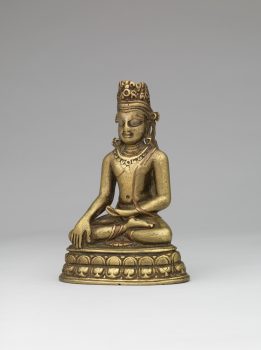Northeastern India
11th century
This is the gesture of the Buddha calling the earth to witness his awakening.
Northeastern India
11th century



This sculpture bears the standard features of late northeastern Indian Buddha depictions. The figure’s head is large, and his clothing clings to his body, its hem indicated by copper inlay. The three points of his crown touch each other at the base and are obscured by the jewels set between them. Behind the ear, ribbons are held by a knot decorated with a blossom, their ends turning upward above the shoulders. The necklace is wide and has large curved pendants, and the earrings are shaped like leaves. Considerable wear has distorted the face and the necklace. This sculpture celebrates the Buddha’s awakening in the northeastern Indian village of Bodhgaya. The Buddha is seated cross legged on a double lotus and touches the earth, a reference to the moment when he called upon the earth goddess to witness his awakening. He wears monastic robes and is crowned and bejeweled. Crowned buddhas have been increasingly popular in Buddhist art from the seventh century onward. In esoteric Buddhist imagery, the crown and its ribbons falling behind the ears signify the Buddha’s awakening.
A state of “waking up” from illusion and seeing the true nature of reality. Buddha Shakyamuni attained enlightenment while meditating under the bodhi tree. Buddhist teaching explains that the accumulation of merit and wisdom are essential for achieving enlightenment, also known as awakening.
A state of “waking up” from illusion and seeing the true nature of reality. Buddha Shakyamuni attained awakening while meditating under the bodhi tree. Buddhist teaching explains that the accumulation of merit and wisdom are essential for achieving awakening, also known as enlightenment.
The antidote to ignorance, with the highest form of wisdom being an understanding of the true nature of reality and all phenomena. In Buddhism studying the nature of interdependence and emptiness is considered an important step for attaining wisdom.
An awakened being who understands the true nature of reality and is free from the cycle of birth, death, and rebirth. While there are many buddhas, Siddhartha Gautama is the historical Buddha, whose teachings became the foundation of Buddhism.
As the cradle of Buddhism, northeastern India was and remains today a region abundant in sacred Buddhist sites. Through the late 13th century, India was the epicenter for the production of Buddhist material and visual culture, with teachers, monks, traders, and pilgrims bringing objects back home to Tibet, western Himalayan regions, Nepal, and beyond.
Get the latest news and stories from the Rubin, plus occasional information on how to support our work.